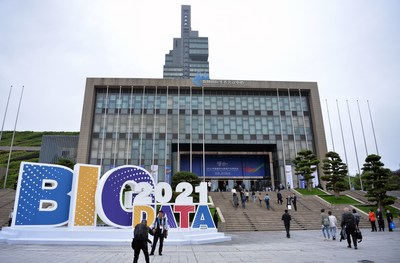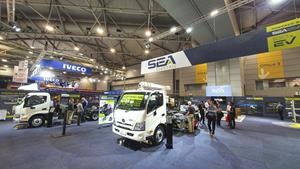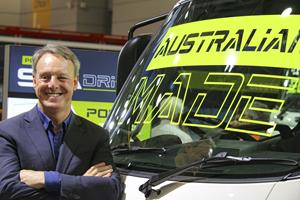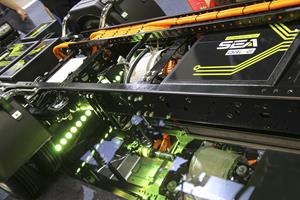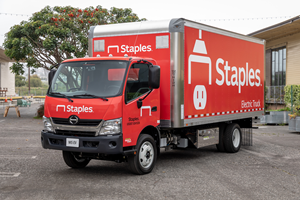La première présentation publique de la gamme complète de camions de marque SEA Electric fixe un cadre de croissance pour la société dans le secteur de l’électrification mondiale
SEA Electric au Brisbane Truck Show 2021

La toute première apparition publique de la gamme complète de camions immédiatement opérationnels de SEA Electric a été présentée lors du Brisbane Truck Show 2021, avec la série complète allant d’une immatriculation de 4,5 tonnes à des porteurs à triple essieu de 22,5 tonnes.
LOS ANGELES, 28 mai 2021 (GLOBE NEWSWIRE) — Le récent Brisbane Truck Show (qui s’est déroulé du 13 au 16 mai au Brisbane Convention & Exhibition Centre, à South Brisbane, en Australie) a accordé une place de choix à la société de technologie automobile mondiale SEA Electric, qui a présenté pour la toute première fois au public une gamme complète de camions électriques immédiatement opérationnels, dotés des systèmes d’alimentation SEA-Drive® exclusifs et du nouveau marquage SEA Electric. La société annonce par ailleurs que la direction mondiale prend les rênes de l’entreprise dans l’ensemble de la région Asie-Pacifique.
La nomination de Bill Gillespie au poste de président de la région Asie-Pacifique, ainsi que la promotion de Glen Walker au rang de vice-président de la région Asie-Pacifique, mettent en commun leur vaste expertise du secteur des transports internationaux et des véhicules électriques dans la région en cette période de croissance pour SEA Electric dans le monde entier. Suite à un récent investissement de 42 millions USD, SEA Electric propose désormais des solutions et des opportunités d’électrification presque partout dans le monde. Aux États-Unis, la société a ajouté de nouvelles capacités d’assemblage, portant le potentiel actuel à environ 60 000 unités par an. Un renforcement supplémentaire des capacités d’assemblage aux États-Unis, y compris dans le domaine des batteries, est attendu dans un avenir proche.
Selon le président et fondateur de SEA Electric Tony Fairweather, SEA Electric a non seulement créé une solution de livraison à faible coût, mais également mis au point un système d’alimentation léger et à tension moyenne qui offre un rendement supérieur au moteur à combustion interne équivalent. « Nos propres camions estampillés SEA, y compris le SEA 300 et le SEA 500 en Australie, sont dérivés des kits OEM livrés en pièces semi-détachées, d’où une plus grande efficacité de transmission à notre clientèle, ainsi qu’un soutien à l’expansion rapide des OEM sur ce segment », a déclaré M. Fairweather.
Le nouveau poste de direction de M. Gillespie permet à ce dernier de tirer parti de la dynamique de la société, qui continue de s’étendre mondialement. « Le produit présenté à Brisbane définit le cadre dans lequel SEA Electric entend s’intégrer en toute transparence aux concessions et aux parcs des équipementiers, en apportant des options d’électrification nouvelles et redynamisées », a déclaré M. Gillespie. Les trois modèles de camions électriques de taille moyenne sont actuellement commercialisés par l’intermédiaire d’une dizaine de concessionnaires agréés en Australie, tandis que plus de 220 revendeurs américains sont disponibles pour répondre aux besoins du marché de l’Amérique du Nord.
Bill Gillespie, président de SEA Electric dans la région Asie-Pacifique

Bill Gillespie rejoint SEA Electric en tant que président de la région Asie-Pacifique, en apportant sa vaste expertise de l’industrie internationale des transports et des véhicules électriques à la région en cette période de croissance pour SEA Electric dans le monde entier.
L’assemblage de pièces semi-détachées assure des solutions efficaces
M. Walker a détaillé l’accord commercial en tant qu’opération d’assemblage SKD (Semi Knock Down) , créant des kits « glider » SKD, un processus tridirectionnel totalement nouveau qui commence par la cabine, les longerons de cadre de châssis, les roues et les composants d’essieux en provenance d’Australie, à l’intérieur de conteneurs provenant du Japon, et qui sont assemblés dès leur arrivée en vue de fournir un châssis roulant destiné à intégrer le système d’alimentation exclusif SEA-Drive® approprié, et créer ainsi un véhicule entièrement assemblé de marque SEA Electric. Les véhicules sont ensuite prêts à être distribués.
Au demeurant, c’est l’efficacité de l’opération d’assemblage SKD qui est réellement innovante pour SEA Electric, en facilitant les solutions et la productivité que la société peut fournir. Compte tenu de la reproductibilité de l’assemblage et de la grande efficacité qui caractérise le procédé, très peu de déchets sont produits, d’où l’évitement fréquent de composants superflus qui auraient été éliminés dans d’autres processus de rétro-assemblage.
« Les accords que nous avons conclus aux États-Unis vont encore plus loin », a déclaré M. Walker. « Nous utilisons le SKD et l’assemblage local glider pour établir la base de référence des programmes en cours en Amérique du Nord et sur d’autres marchés de SEA Electric dans le monde », a-t-il ajouté. À titre d’exemple, lorsque des conteneurs arrivent aux États-Unis aux fins d’assemblage SKD, toute l’électrification est prise en charge par des installateurs agréés en s’appuyant uniquement sur les technologies et la marque du système d’alimentation SEA-Drive®. Le procédé de construction des camions à partir de kits SKD ou de châssis glider offre de multiples avantages par rapport à l’option de rétro-assemblage, notamment des coûts réduits, des temps de fabrication plus courts et une moindre production de déchets.
SEA-Drive®

La technologie d’électrification exclusive SEA-Drive® de SEA Electric s’adapte à une large gamme de plateformes de camions et véhicules commerciaux OEM, et elle a fait ses preuves sur le terrain en totalisant à ce jour plusieurs millions de kilomètres de conduite réels.
Le marché nord-américain, qui abrite depuis peu le nouveau siège social de SEA Electric basé en Californie, dispose du plus fort potentiel pour élever le volume de transformation de véhicules à 60 000 unités par an. L’ajout d’un centre technique à Des Moines et de bureaux prévus à Chicago, Brooklyn et Miami avant août prochain concrétise l’engagement de SEA Electric sur le marché.
Avec son volume disponible et sa capacité ambitieuse d’assemblage de la technologie SEA-Drive®, SEA Electric fournit des solutions immédiatement exploitables et rentables, qui peuvent être facilement mises à l’échelle pour répondre aux besoins de n’importe quelle flotte, qu’il s’agisse de véhicules de livraison nouveaux ou existants pour lesquels de nouvelles capacités de conduite électriques sont requises. L’électrification des autobus scolaires jaunes est également très demandée aux États-Unis.
L’aspect de la croissance commerciale qui est le plus important, en ce qui concerne le kit SKD et l’assemblage glider pour les OEM, est peut-être la possibilité, pour la gamme de véhicules SEA Electric, d’être disponible à partir d’un réseau de revendeurs assurant une assistance complète en termes de vente, de garantie et de service.
SEA Electric SEA M5 EV

Le châssis des véhicules SEA M5 EV présenté dans ce camion de livraison urbain utilise la plateforme exclusive de groupes motopropulseurs SEA-Drive® de SEA Electric pour les véhicules de classe 5. L’unité bénéficie d’une garantie de 5 ans sur les batteries et d’une garantie système de 3 ans ou 50 000 miles (80 000 kilomètres).
Systèmes d’alimentation SEA-Drive®
Les systèmes d’alimentation exclusifs SEA-Drive® de SEA Electric sont disponibles dans une gamme de configurations variée. Ils se destinent aux modèles tout-électriques d’une capacité de 4,5 à 26 tonnes (9 990 à 57 500 lb PNBV). Chaque système est conçu pour délivrer 3 000 cycles de charge sur la base d’une recharge nocturne complète, si l’opération est réalisée cinq jours par semaine, en offrant une capacité de performances optimales résultante pendant 10 ans.
Le Brisbane Truck Show a dévoilé cinq nouveaux modèles de camions de la marque SEA Electric, dont le lancement des véhicules électriques SEA 300-45 et SEA 300-85. Les deux modèles sont entièrement conformes aux spécifications ADR et assemblés à Melbourne en vue de leur distribution en Australie.
L’avenir de SEA Electric
Alors que les racines de SEA Electric sont ancrées en Australie, où sont également implantées diverses capacités de fabrication et de technologie, la croissance de la société en Amérique du Nord apporte un modèle commercial qui peut également être reproduit en Europe. Les sites de transformation américains actuels sont présents dans l’Illinois, le Michigan, la Caroline du Nord, l’Indiana et la Californie.
Suite à sa récente annonce de financement par actions de 42 millions USD, SEA Electric a également clôturé son dernier achat de 1 000 batteries de véhicules électriques auprès de son partenaire technologique de longue date Soundon New.
Technologie énergétique. Cette transaction importante prend en charge les principaux modèles dotés des systèmes d’alimentation brevetés de SEA Electric : SEA-Drive® 70, 100 et 120. Si la plupart des unités initiales sont prévues pour les États-Unis, le reste rejoindra les stocks de SEA Electric en Australie, en Nouvelle-Zélande et en Asie du Sud-Est, et accompagnera les débuts de la société sur le marché européen.
À propos de SEA Electric
La société mondiale de technologie automobile SEA Electric a été fondée en Australie en 2012, créant sa technologie exclusive de système d’énergie électrique (connue sous le nom de SEA-Drive®) pour les flottes de livraison et de distribution urbaines du monde entier, ainsi que des utilisation dans des bus scolaires à propulsion avant.
Glen Walker, vice-président de SEA Electric pour la région Asie-Pacifique

En tant que vice-président de SEA Electric pour la région Asie-Pacifique, Glen Walker dirige les activités opérationnelles de l’APAC pour la société, apportant ses près de deux décennies d’expérience des secteurs de l’automobile et des transports en Australie.
Largement reconnue comme un leader du marché de l’électrification des véhicules utilitaires à l’échelle mondiale, SEA Electric possède une présence mondiale, déployant des produits dans six pays dont les États-Unis, l’Australie, la Nouvelle-Zélande, la Thaïlande, l’Indonésie et l’Afrique du Sud, avec collectivement plus d’un million et demi de kilomètres d’opérations internationales testées de manière indépendante par OEM et fonctionnelles.
Les ventes mondiales, l’après-vente et l’ingénierie de la société sont représentées dans toutes les filiales, tandis que l’Amérique du Nord, où se situe son siège social, dispose de la plus grande capacité d’aménagement de véhicule pour SEA Electric avec plus de 60 000 unités par an.
TÉLÉCHARGEMENTS DU COMMUNIQUÉ DE PRESSE
Veuillez suivre ce lien pour télécharger ce communiqué de presse et des versions en HAUTE RÉSOLUTION de nos images SEA Electric et autres ressources éditoriales connexes.
https://www.dropbox.com/sh/dqt5opk580rf4em/AAB2vfLr9s2UsePMwcKqSsMTa?dl=0
Contact : Deb Pollack, Communications stratégiques
Tél. : 805.320.9248 – E-mail : deb@debpollack.com
Les photos accompagnant cette annonce sont disponibles sur :
https://www.globenewswire.com/NewsRoom/AttachmentNg/77af3321-4ff7-4b80-b687-e2264e18e5db/fr
https://www.globenewswire.com/NewsRoom/AttachmentNg/147e7737-960e-4586-b145-38e83c1bb1f5/fr
https://www.globenewswire.com/NewsRoom/AttachmentNg/8036eab5-56f0-419e-8287-1e80f8774dd6/fr
https://www.globenewswire.com/NewsRoom/AttachmentNg/c0e6adc5-97cf-4680-a191-86d43f2593af/fr
https://www.globenewswire.com/NewsRoom/AttachmentNg/b8732bf2-6ff6-47d1-af4f-47db028de6df/fr

